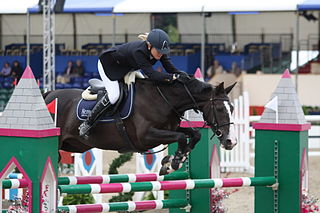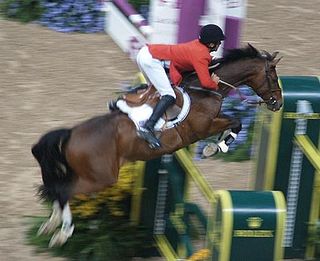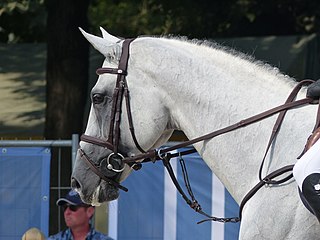A horse breed is a selectively bred population of domesticated horses, often with pedigrees recorded in a breed registry. However, the term is sometimes used in a broader sense to define landrace animals of a common phenotype located within a limited geographic region, or even feral "breeds" that are naturally selected. Depending on definition, hundreds of "breeds" exist today, developed for many different uses. Horse breeds are loosely divided into three categories based on general temperament: spirited "hot bloods" with speed and endurance; "cold bloods," such as draft horses and some ponies, suitable for slow, heavy work; and "warmbloods," developed from crosses between hot bloods and cold bloods, often focusing on creating breeds for specific riding purposes, particularly in Europe.

Warmbloods are a group of middle-weight horse types and breeds primarily originating in Europe and registered with organizations that are characterized by open studbook policy, studbook selection, and the aim of breeding for equestrian sport. The term distinguishes these horses from both heavy draft horses and refined light saddle horses such as the Thoroughbred, Arabian, and Akhal-Teke. Although modern warmbloods are descended from heavier agricultural types systematically upgraded by hotblood influence, the term does not imply that warmbloods are direct crosses of "cold" and "hot".

A Hanoverian is a Warmblood horse breed originating in Germany, which is often seen in the Olympic Games and other competitive English riding styles, and has won gold medals in all three equestrian Olympic competitions. It is one of the oldest, most numerous, and most successful of the Warmblood breeds. Originally a cavalry horse, infusions of more Thoroughbred blood lightened it to make it more agile and useful for competition. The Hanoverian is known for a good temperament, athleticism, beauty, and grace.

The Oldenburg or Oldenburger is a warmblood horse from the north-western corner of Lower Saxony, what was formerly the Grand Duchy of Oldenburg. The breed was built on a mare base of all-purpose farm and carriage horses, today called the Alt-Oldenburger. The modern Oldenburg is managed by the Association of Breeders of the Oldenburger Horse, which enacts strict selection of breeding stock to ensure that each generation is better than the last. Oldenburgers are tall sport horses with excellent gaits and jumping ability. The breeding of Oldenburg horses is characterized by very liberal pedigree requirements and the exclusive use of privately owned stallions rather than restriction to a state-owned stud farm.

The Selle Français (SF) is a breed of sport horse from France. It is renowned primarily for its success in show jumping, but many have also been successful in dressage and eventing. An athletic horse with good gaits, it is usually bay or chestnut in color. The Selle Français was created in 1958 when several French riding horse breeds were merged into one stud book. The new breed was meant to serve as a unified sport horse during a period when horses were being replaced by mechanization and were transforming into an animal used mainly for sport and leisure.

The Holsteiner is a breed of horse originating in the Schleswig-Holstein region of northern Germany. It is thought to be the oldest of warmblood breeds, tracing back to the 13th century. Though the population is not large, Holsteiners are a dominant force of international show jumping, and are found at the top levels of dressage, combined driving, show hunters, and eventing.

The Irish Sport Horse, or Irish Hunter, is an Irish breed of warmblood sporting horse, used mostly for dressage, eventing and show-jumping. It was bred from 1923 by cross-breeding of Irish Draught and Thoroughbred stock. There was some limited intromission of Hanoverian, Selle Français and Trakehner blood in the 1990s. It is a recognised true breed – foals may only be registered in the main section of the stud-book if both parents are registered in that section.
Gem Twist was a 16.3 hands world champion American Thoroughbred show jumping horse registered under the name Icey Twist. Bred by equestrian Frank Chapot, Gem Twist had an incredible career at the Grand Prix level. The gelding is the only horse to have won the "American Grand Prix Association Horse of the Year" title three times, and is regarded as one of the best show-jumpers in history.

Gunrock is the official mascot of the UC Davis Aggies, the athletic teams that represent the University of California, Davis, and was based on Gunrock (1914–1932), an American Thoroughbred stallion, and the son of English Triple Crown winner Rock Sand. He was related to the American Thoroughbred racehorse Man O' War (1917–1947), who was out of Mahubah (1910–1931), bay Thoroughbred mare by Rock Sand out of Merry Token. Gunrock was bred by Clarence Mackay, and likely born in Kentucky in 1914. He had an unsuccessful racing career as a 2-year-old, and was retired to stud by age 6 in 1920.

The Belgian Warmblood or Belgisch Warmbloedpaard is a Belgian breed of warmblood sport horse. It is bred for dressage, for show-jumping and for three-day eventing. It is one of three Belgian warmblood breeds or stud-books, the others being the Zangersheide and the Belgian Sport Horse – to which it is quite similar.

The Westphalian or Westfalen is a warmblood horse bred in the Westphalia region of western Germany. The Westphalian is closely affiliated with the state-owned stud farm of Warendorf, which it shares with the Rhinelander. Since World War II, the Westphalian horse has been bred to the same standard as the other German warmbloods, and they are particularly famous as Olympic-level show jumpers and dressage horses. Next to the Hanoverian, the Westphalian studbook has the largest breeding population of any warmblood in Germany.

The Bavarian Warmblood is a horse breed of southern Germany that developed from an older Bavarian heavy warmblood breed called the Rottaler. Since mechanization in the mid-20th century, the Bavarian Regional Horse Breeders' Society has concentrated on producing a riding horse for the Olympic disciplines and recreational riding based on other European warmblood bloodlines.
An Austrian Warmblood is a warmblood type of horse registered with the Arbeitsgemeinschaft für Warmblutzucht in Österreich. Although the studbook is made up of jumping and dressage horses from many other countries, the mare base consists of native horses with a long history. The AWÖ keeps an open studbook, in which mares and stallions must pass rigorous inspections before becoming breeding stock.

The Rhenish Warmblood, German: Rheinisches Warmblut or Rheinisches Reitpferd, is a German warmblood breed of sport horse. It was registered with the Rheinisches Pferdestammbuch until 2014, when the Hannoveraner Verband took over management of the stud-book. It is traditionally bred around Warendorf State Stud, which it shares with the Westphalian, and is bred to the same standard as the Westphalian and other German warmbloods, such as the Bavarian Warmblood, Mecklenburger, Brandenburger, and Württemberger.

The Zweibrücker is a type of German warmblood horse bred in Rhineland-Palatinate and Saarland. Traditionally, the breeding of Zweibrücken was centered on the onetime Principal Stud of Zweibrücken but since 1977 has been under the jurisdiction of the Horse Breeders' Association of Rhineland-Palatinate-Saar (PRPS). The modern Zweibrücker is an elegant, large-framed, correct sport horse with powerful, elastic gaits suitable for dressage, show jumping, eventing and combined driving.

A part-Arabian, partbred Arabian or, less precisely, half-Arabian, is a horse with documented amounts of Arabian horse breeding but not a purebred. Because the Arabian is deemed to be a breed of purebred horse dating back many centuries, the modern breed registries recognized by the World Arabian Horse Organization generally have tightly closed stud books which exclude a horse from registration if it is found to contain any outside blood. However, Arabian breeding has also been used for centuries to add useful traits to countless other horse breeds. In the modern era, crossbreeding has been popular to combine the best traits of two different breeds, such as color, size, or ability to specialize in a particular equestrian discipline.

The Belgian Sport Horse, Dutch: Belgisch Sportpaard, French: Cheval de Sport Belge, is a Belgian breed of warmblood sport horse. It is one of three Belgian warmblood breeds or stud-books, the others being the Belgian Warmblood and the Zangersheide. It is bred for dressage, for show-jumping and for three-day eventing.

Hello Sanctos is a bay gelding. He is listed in stud-book sBs and ridden in show jumping. From 2014 to 2015, he was the best show jumping horse in the world. His rider was Scott Brash. He is the only horse in the world to complete a Grand Slam of Show Jumping. He stopped due to an injury in December 2015. The horse returned in February 2017.
Horse cloning is the process of obtaining a horse with genes identical to that of another horse, using an artificial fertilization technique. Interest in this technique began in the 1980s. The Haflinger foal Prometea, the first living cloned horse, was obtained in 2003 in an Italian laboratory. Over the years, the technique has improved. It is mainly used on high-performance but castrated or infertile animals, for reproductive cloning. These horses are then used as breeding stock. Horse cloning is only mastered by a handful of laboratories worldwide, notably in France, Argentina, North America and China. The technique is limited by the fact that some differences remain between the original and its clone, due to the influence of mitochondrial DNA.

The Polish sport horse is a studbook of sport horses, from Poland. This recent studbook, which does not constitute a breed, comes from selective breeding for equestrian sports. It is selected from Malopolski and Wielkopolski, both of which perform poorly on the international sporting scene, and from crosses with various sport horses. The animals are large, with muscular rumps and strong legs.

















